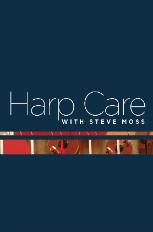In the last two posts, I have discussed some of the differences between nylon and gut harp strings. I strongly recommended that, despite their significantly higher cost, all harpists use gut strings in the fifth through the third octaves. In this range, gut strings provide more dynamic range, a richer, clearer sound, and more accurate intonation.
If gut strings are so much better, shouldn’t they be used in every octave? Not necessarily. Let’s consider the first and second octaves in turn.
Every new pedal harp I know of comes with nylon strings installed in the first octave, and the vast majority of harpists keep their harps’ first octaves strung in nylon. Why? For one thing, gut strings in this register are pretty fragile and subject to breakage. For another, the qualitative difference in sound that I have discussed between gut and nylon strings is far less pronounced in this range. I have mentioned before that nylon strings have a more complex, or layered sound, with greater emphasis on partial pitches, or overtones. In the first octave, though, many of these overtones are so high the human ear doesn’t hear them, so the string’s fundamental pitch is more prominent by default. Those overtones that our ear does perceive tend to give first octave nylon strings a brighter sound than gut strings, and this makes them more distinct and easier to hear, especially in ensemble situations. So, while you might wish to experiment with gut strings in your first octave, I generally recommend nylon strings.
New pedal harps are delivered with gut strings in the second octave, but you will run into quite a few harpists who have replaced these with nylon strings. For many people, this is an economic decision, and this makes sense. In the second octave, nylon strings give a strong, reasonably clean sound, with acceptable intonation. They are certainly worth a try. If they sound just as good to your ear as gut strings, then by all means use them, as you’ll save some money. Some harpists, though, are sticklers for intonation, and if you are one of them I’d encourage you to use gut strings in the second octave. Gut strings can be regulated more accurately than nylon strings. Since they flex less, their intonation will vary less as your dynamics change, while a nylon string played fortissimo will then to sound flatter than the same string played mezzo piano. If you are a newer or casual player with a soft touch, you will demand less from your harp, and nylon strings may serve you just fine.
I have talked to a number of symphony harpists who prefer nylon strings in the second octave because their brighter quality helps them “cut through” the other instruments in the orchestra, and in this context the harp needs all the help it can get. If you play in a lot of orchestral or other group situations, you may want to try nylon strings in your second octave to see if they give your sound an extra boost.
To sum up, then, I encourage most harpists to use gut strings in the third, fourth, and fifth octaves, and nylon strings in the first octave (and “zero” octave). Your choice in the second octave depends on your preference and your situation, so I would encourage you to experiment with both.



Thanks very much for this detailed information.
I have a Semi Concert Pedal Harp Aoyamah model Vega.
So I understand that the 1 st and 2 nd to use Nylon strings.
and 3rd m 4th and 5 the to use Gut stintrings.
Also does the new pedal Harp come with Nylon strings on the 2nd?
Also Can I use mix brand gut strings on my harp. for example Bow brand and Vanderbilt brand on my harp together. ?
Thanks for sharing you knowledge.
With respect,
Doron
Doron,
Some new pedal harps come with nylon strings in the second octave, and others with gut. It depends on the brand and model. I am not sure about the Aoyama Vega. You might check with Classic Harps Northwest on that. It does not harm the harp to mix different brands of gut strings, but you may notice a difference in sound, tension, and feel. Generally, I would recommend staying with one brand but you can substitute in an emergency.